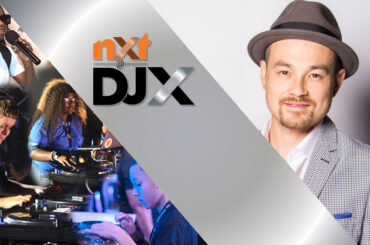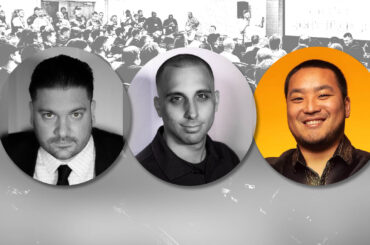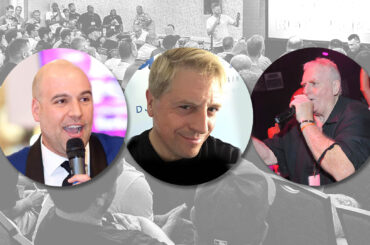Wake up, get a coffee, climb a mountain, work on music for rest of the day.
Back in 2013, that’s what the schedule looked like for James S. Tomaszewski, Jr., when he was attending college in a small New England suburb. This was a prolific time for Tomaszewski who squashed his full name together into an acronym of sorts, JSTJR, under which he flooded his SoundCloud stream with original productions. That’s where Diplo found Tomaszewski’s bootleg of Major Lazer’s “Bubble Butt,” and the following year, tasked him to create the drum track for “Light It Up” off Major Lazer’s smash album, Peace Is The Mission.
This was the catapult for JSTJR, whose contemporary electronic-dance take on indigenous sounds, specifically baile funk, zouk bass, and moombahton, has seen releases on Fool’s Gold, Mad Decent and its Jeffrees and Good Enuff imprints, Nest HQ, Smog Records, La Clinica, Fania, as well as on numerous compilations, not to mention a host of remixes. For his latest release, the three-track Never Squad Down EP, Tomaszewski joins the Insomniac Records family, including representing them at their famed festivals on their label-specific stage.
“For this EP, the setting is dancefloor-club music, and I’m importing global-bass sounds into it,” explains Tomaszewski, sitting in a trendy café in Los Angeles, his adopted hometown of the last year and a half. “Until now, I would use a snare from a dubstep song, for instance, in this crazy baile funk or slow zouk bass track, trying to create the club setting inside that music.”
The EP’s three tracks represent JSTJR three ways, as Tomaszewski puts it, including a three-part video series. The title track is his take on house music with a bumping beat and a snarling vocal courtesy of Uniiqu3. “Break It Down” is a collage-style trap number that incorporates many aspects of Tomaszewski’s multiple musical leanings. “Shake That” is as Brazilian a rumpshaker as he can make with Orlando’s Ma-less tethering it with her vocals.
Since moving to L.A. from Nashua, N.H., Tomaszewski has made the shift in his home studio from FL Studio to Ableton Live. Staying in the box, his only external piece, other than his Yamaha HS8 monitors, is a small MIDI keyboard. On Ableton, Tomaszewski sticks with the stock plug-ins, not programming MIDI, but rather manipulating vocal samples as sound sources. “I’ll take a vocal and rhythmically chop it,” he says, “continuously saturate and distort it until it’s pretty much not a vocal anymore.”
Remembering his FL Studio days, Tomaszewski says, “I miss how I was as a producer back then. When I was younger, I was in a different space. I made my music way louder, I would blast it for eight hours, which is bad for you and bad for your music. But it made the music what it was, which was this saturated, loud thing, and people enjoy that. Now it’s like I’m grown up with a more refined sound.”
Much of these refined sounds are from acoustic samples, primarily found in Brazilian music, others from producer packs. With all the influence Tomaszewski has taken from this region, when playing in Sao Paolo he was met with responses from the locals like, “It’s so cool to have you out here,” or “We don’t have this often,” or “We don’t get a lot of global bass music.”
Yet, his best audience has been in Los Angeles, so far, where in 2016 he started his monthly party, Plugged In. The event moved from a club to a sporadic, illegal, afterhours warehouse setting, which has worked out to the benefit of the music.
“The audience on the internet that’s loving this music is huge,” says Tomaszewski. “If you got all of them at a venue, it would be the biggest thing, but there is no concentrated spot for it physically. That’s what we’re trying to do with Plugged In, bring this club music that was born on the internet into the actual club—first in L.A., then hopefully move it around the world.
“What I sought in moving to Los Angeles is different to what I gained,” he continues. “I was searching for the center of the EDM world, running into people and building face-to-face relationships. What I found was an audience for what I like to do in a big way, which I never really had.”
At these parties is where Tomaszewski can really let loose in his DJ sets, experimenting with styles, pulling from songs he sorts by BPM, with a crowd that is receptive to all sounds. As he graduates to festival stages, his USB has playlist folders created based on vibe, organized by transitions he feels work well, in order to be better organized.
“As a DJ in a club, you can get kind of weird and caught up in something, but it’s easy to get yourself out of there,” says Tomaszewski. “On the bigger stages, I find myself getting caught up, and sometimes things aren’t working, I’m stressed and I don’t have a go-to to get back on track. That’s where the playlists are rising from, being more prepared as a DJ – and then I have to remember to play my own songs. I’m always forgetting to do that because I’m so into what I’m doing.”







